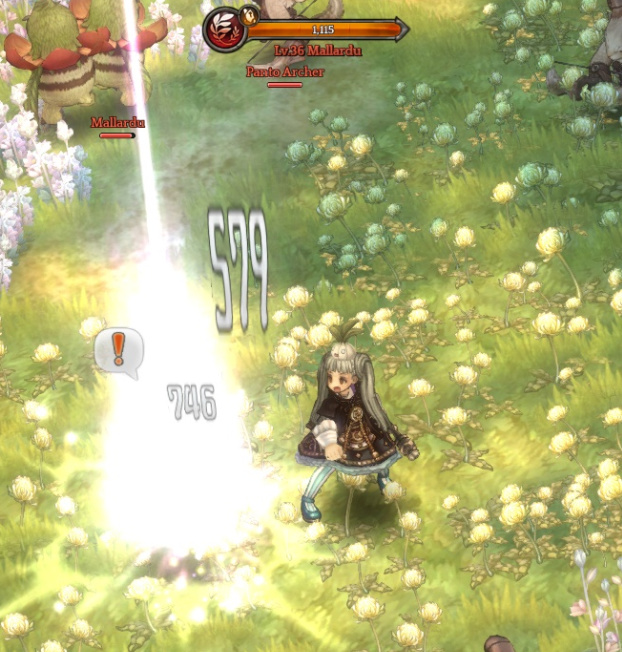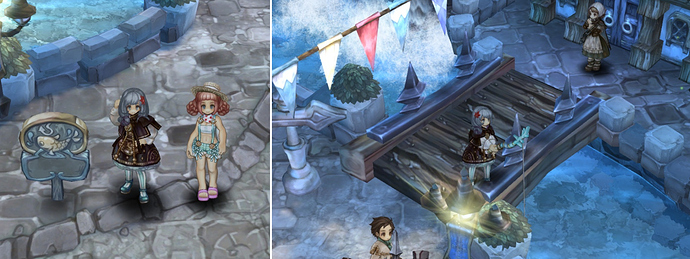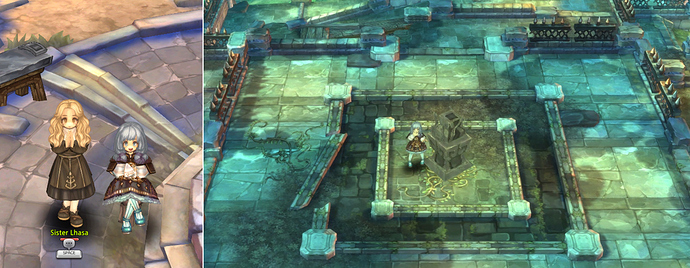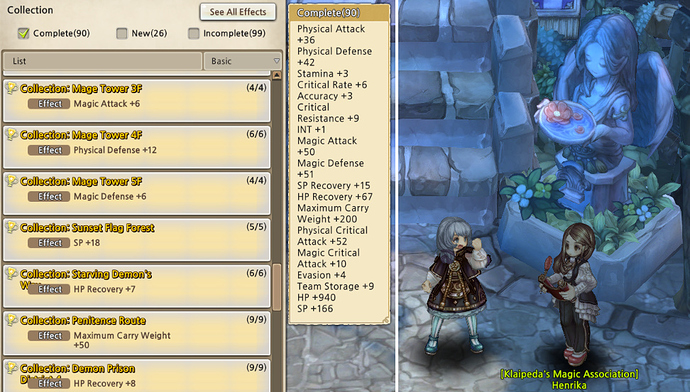Glug Glug Glug: SP management for newbies and veterans!
Do you see yourself in this picture? Then I hope this guide makes your experience in ToS a little better!
Contents
- Introduction
- Terms used in this guide
- Getting started
- Tools and mechanics that help managing your SP at the early levels
- Expanding your knowledge on SP management at the middle levels
- Mastering SP management when you are on the final stages of the game
- Authorship
Introduction
SP is the energy source used for most of your character’s skills. With [Re:Build], its proper management became much more important, be it for low level and high level characters, each one with different challenges. This guide was made with the aim to help new and veteran players with tips on how to get used with the increased difficulty due to the PvE rebalance and the impact [Re:Build] had on SP management. It is expected that the reader becomes aware of all the available options to ease the burden on the SP consumption of their character.
Terms used in this guide
- SP (Spell Points): resource used to cast most skills in the game. Slowly regenerates over time and can be recovered with consumables or special effects from skills and monster cards.
- Re:Build: update deployed on iTOS in January that overhauled the class system and rebalanced the game content. https://treeofsavior.com/page/news/view.php?n=1584
- Monster Cards: special cards that can be equipped by the player’s character, granting diverse effects. https://treeofsavior.com/page/guide/view.php?n=33
- Base or starting class: one of the 5 available classes the player chooses when creating a new character, determining what weapon-types and sub-classes this character has access to.
- Sub-class: classes that the player can advance to as they progress throughout the game, defining what skills and attributes their character has access to.
- Stat points: term usually used when referring to the main stats of the player’s character: STR, DEX, CON, INT and SPR. These points are automatically calculated based on what classes the character has. They can also be increased with manually allocated extra stat points gained in certain quests in the game, collections and bonus effects from equipments.
- Collections: lists of obtainable items from certain maps or regions that grant different bonus effects for all the player account’s characters for each collection completed.
- Build: the class and skill point allocation structure of the character that can be planned using online tools like https://tos.guru/itos/simulator
- Attributes: abilities that enhances your character’s skills, increasing the damage of offensive skills or the supportive effects of utility skills, or even changing how certain skills work. They can be purchased with attribute points in the Skill and Attributes window https://treeofsavior.com/page/guide/view.php?n=10
Getting Started
One of the first steps in order to have an enjoyable experience in ToS is planning your character. This game has 5 starting classes that you can choose from: Swordsman, Archer, Wizard, Cleric and Scout. While this is a permanent choice, you will have to select a class to advance every time you reach the maximum class level for your last advancement class. The base class is maxed at class level 15, while your 3 sub-classes are maxed at class level 45. You can advance up to 3 times and that will probably happen when your character level is 14~16, 120~130 and 270~280.
Since all classes have different issues and their own level of difficulty, it is advised to plan your build in order to maximize the efficiency of your character during the leveling process, especially if you are going to play solo until the endgame, where most of the content is group-oriented.
If you are going to play with a group to level up together, the burden on SP consumption is significally reduced, so choosing less SP efficient classes will not be an issue for you. When this is not the case, avoiding certain classes will help you to have an easier time leveling up. Having a high SP efficiency means that the class has mostly skills that will help you defeating monsters spending less SP compared to other classes. Classes with low SP efficiency should be avoided by new players for their first class advancement. The idea here is to pick classes that are easy to level up with then adjust your build later since Re:Build allows you to freely change your build by spending class points to switch sub-classes.
Sub-classes with good SP efficiency and recommended for your first advancement:
(The following classes can deal with bosses and large packs of monsters spending less SP compared to other classes of their respective class tree)
- Swordsman: Barbarian and Doppelsöedner
- Archer: Ranger and Mergen
- Wizard: Pyromancer
- Cleric: Exorcist and Chaplain
- Scout: Bullet Marker and Corsair
Sub-classes that should be avoided for your first advancement:
(Classes listed here fall into four possible cases: poor SP efficiency, core attributes that can only be unlocked at higher levels, lack of offensive skills or classes that use reagents to cast most of their skills)
- Swordsman: Dragoon, Retiarius and Templar
- Archer: Pied Piper, Falconer, Hunter, Wugushi, Sapper, Fletcher and Quarrel Shooter
- Wizard: Sage, Necromancer, Sorcerer, Chronomancer, Onmyoji, Taoist, Shadowmancer, Alchemist and Elementalist
- Cleric: Dievdirbys, Oracle, Pardoner, Kabbalist, Paladin and Zealot
- Scout: Linker, Thaumaturge, Enchanter, Schwarzer Reiter and Squire
Tools and mechanics that help managing your SP at the early levels
This section will cover:
- Questing to receive potions
- Pardoner buff shops
- Fishing and grilling silver fishes on campfires
- Combat tips to minimize SP usage
- Using EXP cards
Most (if not all) leveling guides tell you to grind on maps with high mob density. This is especially efficient for leveling up alt characters, since players doing it have a good initial budget to bank the first needs of new characters. However, although new players can enjoy the contents of their starter boost packs, no potions are given in these packs.
Every time you advance to the next sub-class, you’ll receive 100 HP and SP potions. This should be enough until the next class advancement, but, if you need more potions and grinding is not giving you enough money, questing is a good way to acquire money and potions at the early levels.
The next important thing are the buffs that can be purchased from Pardoner Buff Shops. Graces come at 800 silver each and last 45 minutes, giving you a significant boost in damage. Buy only the offensive buffs (Additional Holy Hits and Additional Holy Damage). These are very important since they make both skills and basic attacks a lot stronger at the early levels. When you kill monsters faster, you’re saving SP. Sometimes, even using only basic attacks is enough to quickly kill monsters with these buffs.
Now let’s go to the fields! Time to test our damage with these buffs. See? With only 1,600 silver you will be oneshotting any monster there for 45 min. With the silver you collected with the initial quests in the first map, you should have more than enough to afford these.
Some people feel bored killing monsters using only basic attacks, so they will use their skills for grinding. I cannot blame them, since it is more fun to kill enemies using skills with cool effects. Sometimes you will not be able to curb the enthusiasm to spam all your skill set and potions alone will not be enough to sustain your SP usage… So here is another way to recover SP: campfires and silver fishes. Go back to Klaipeda and find Juha in the northern section. Once per account, you get a starter kit with a basic fishing rod and enough bait for at least two rounds of fishing. Follow her instructions and leave your character fishing for a few minutes.
Now, if you want to save up potions, you can recover both HP and SP at increased speed and efficacy near a campfire. This is not a really efficient way to recover SP, but if you are grinding on a certain spot, sitting close to a campfire with the buff gained after eating grilled fish will help you save potions.
As you progress through the game, if you are doing quests, you will encounter stronger bosses with lots of HP. Even if your basic attacks are strong thanks to the Pardoner buffs, you should probably have opened your level 50 booster pack that granted you a very strong weapon. Therefore, using skills is probably a better way to kill quest bosses depending on your build. During that situation, it is important to learn your rotation.
An optimized rotation has a good SFR/SP ratio, leading to a lower SP usage. Some classes use certain setups like applying a debuff with a skill, then using another skill that deals increased damage if the enemy is under the effect of that debuff. Chaining skills in a certain order where you get the most from these synergy effects is mandatory to achieve an optimized rotation.
Meanwhile, other classes have no setups, but some of their skills deal only 1 hit while other skills deal a large amount of hits. Even with a lower SFR, multi-hit skills can deal much more damage than high SFR single hit skills because elemental property damage or additional damage (like Blessing) are added to every hit your attacks deal. With a +300 damage bonus from “Grace: Additional Holy Damage”, for example, a single hit skill deals only 300 additional damage, while a skill that deals 10 hits will deal 3,000 additional damage.
Finally, another accessible way of recovering SP for new players is more like a last resort, but useful if your character is about to level up and your SP bar is almost empty. Each quest will give you a number of EXP cards. One way to use them is for leveling up to recover HP/SP, saving potions. The amount of EXP required to level up is significantly lower after certain points called EXP curve reset points. For the character level, they occur at lvl 16, 46, 86, 136, 186, 236, 281 and 360. As for the class levels, leveling up gets significantly faster at class lvl 1, 16 and 31. In these level ranges, less EXP cards will be required to level up and restore all your HP and SP, so keep that in mind.
Expanding your knowledge on SP management at the middle levels
This section will cover:
- Uphill Defense Mission
- Collections
- Unidentified items
Upon reaching level 120, a challenging party-oriented PvE content is unlocked: Uphill Defense Mission. It consists of an instanced map where you and your allies have to defend a Divine Torch from attacking monsters over 30 stages of increasing difficulty. Even bosses can appear there! Surviving each stage makes a reward box to appear close to the Divine Torch, giving you and your allies a certain reward: potions, gem abrasives, coins to spend in the uphill shop and others. Doing it in a full party is strongly advised since you will start receiving the good rewards at stage 10+.
Doing Uphill is a good way to get Keistas Restoration Potions. They restore a significant amount of HP and SP per second and don’t share the same cooldown as alchemist and general merchant potions, which is very useful when your potions are on cooldown and you’re out of SP. Another way of obtaining Keistas Restoration Potions is doing the Mishekan Forest questline, but that becomes available only at lvl 317. After finishing it and talking to all NPCs there until you see the two possible dialogues with each NPC, an extra quest is given by Curtis, that rewards with you with a box containing 1 Practonium, 20 Mithril ores and 20 Keistas Restoration Potions lvl 3.
Tree of Savior has more than 200 maps and almost all of them have a chest containing a collection that corresponds to the map or its region. These collections should be delivered to NPCs from the Magic Association. Henrika is the associate in Klaipeda. You can view the Collections by talking to her or opening the Collecitons list in the Adventure Journal in the Exploration tab.
Each collection gives a tiny bonus, but after compleging many collections, you will se that they add up for a good amount of bonus effects for all your characters. When it comes to SP management, Collections can contribute with about 50 SP recovery and a significant increase in your SP pool. Besides, Collections correspond to a significant portion of your Exploration level, which means interesting rewards from the Wings of Vaivora NPCs. Another tip: some collection items can also be obtained while fishing, so while you’re getting your Silver Fishes to grill over a campfire, you might get rare collection items too.
And to finish this section, let’s talk about unidentified items. You will find many of those during your journey. For a small amount of silver, you can identify them in Appraiser shops or turn them into dust. While SP recovery should not be a primary stat to look for, they are nice to have on top of important stats such as your character’s main stats. Low level gear usually has 5 to 20 SP recovery, while lvl 380 unidentified gear can reach 50 SP recovery.
Mastering SP management when you are on the final stages of the game
This section will cover:
- Awakening
- Monster cards
- Brewing your own potions
- Adjustments to your character’s build
- Measuring up the challenges you can take
Authorship
Team name: Pokart
Server: [SA] Silute







